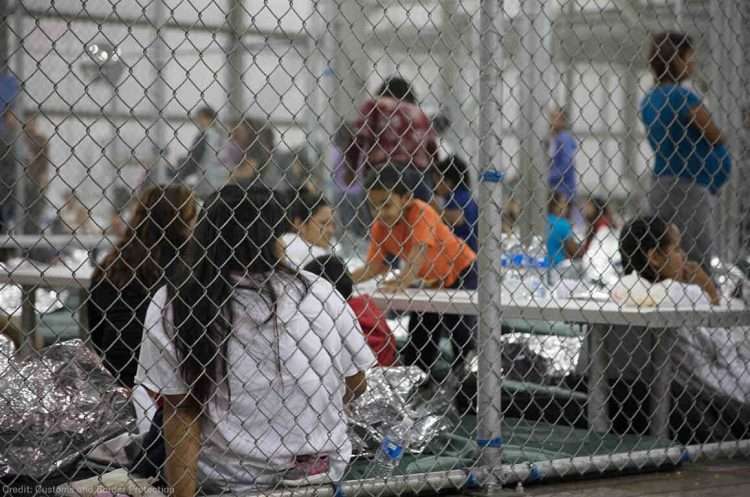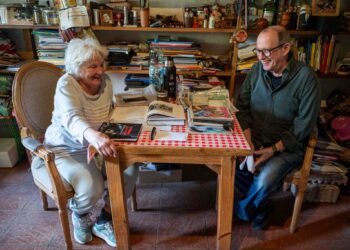This is Daniela’s migratory story, told by herself, once she arrived on U.S. soil:
When we arrived they sat us outside, where they receive people and where the computers are. There is also a baggage storage where they put all your belongings and give you a ticket. There were thousands of people before us, which means that they arrived at dawn or around six in the morning.
There a young man gave us a ticket and they called us by name, they took our picture, and we had to sign and put our fingerprint on a document. There was a young woman, one of those security police officers of Mexican origin who treated us extremely badly, she did treat us badly; from here to there very few were the ones who mistreated us, but she treated us very badly. It was extremely cold, really cold, and she ordered us to take off our coats, even the children who had come on the “journey.” She was not interested that they were children: she ordered them to take off their coats.
I entered there on the sixth of March and left on the ninth at dawn. There were many women in the shelter, and I said to myself, “gosh, I can’t believe they have all of us here,” but that’s how it was, and all the time with the lights on. On the floor, there were about four small mattresses, those mattresses for judo, the sports ones, very hard. And they gave us some packages with some silver “nylon” sheets that you open and use to cover yourself. There was also a toilet with a small wall where you have to “relief” yourself like that, in front of everyone, because there is no door, there is nothing, we placed the wastebasket in front to have a bit of privacy. And that was just to relieve yourself: there was nowhere to bathe or brush your teeth, they only gave you some wipes. What I did to wash my teeth was rinse my mouth with plenty of water, because it felt bitter, like someone who has chewed ackees.
They gave us to eat a chicken sandwich, some energy tablets, an apple, and some small juices that were warm and no one could drink. At noon what they gave was a cold, frozen taco, which they took out of the refrigerator. Some cold ham tacos that I think were the best despite how cold they were, and again the apple, the energy tablet and the little bowl of apple juice. And at night they gave us a spicy hamburger again, so much so that no one would eat it, and the same things that I told you before.
There we stuck to a glass to see outside because we were all very desperate, the hours did not pass. And when we knocked for someone to come because the toilet paper ran out or something like that, we asked what time it was. In general, they hardly attended to us. There were girls who knocked and said, “my head hurts,” “I feel bad.” I even saw an Argentine girl, her name was Martina, just 19 years old, she hadn’t eaten for days, she didn’t want to eat, and everyone started knocking, because the girl was sick, and we started to worry. Then an officer, surnamed Martínez, arrived and told us: “stop bothering,” and he closed the door in our face in such a way that he almost caught one of the girls’ fingers with those metal doors, and he would have ripped it off and nothing.… We were trying to explain to him that the Argentine girl was not well, but he told us not to talk to her, that there was nothing wrong with her. He didn’t open it for us until, luckily, it was lunchtime and, when he opened it, the girl was no longer passed out, but she was still lying on the floor. So he told us to get out, not to help her, that she didn’t have anything wrong with her, but when we came back from lunch the girl wasn’t there. After, in the afternoon we saw her again, and she told us that they left her there for a while and gave her a pill, nothing more.
Nothing happened over the weekend, but on Monday afternoon they asked me about the piece of paper they had given me so that I could write the name of my contact in the United States, his address and the relationship we had; and on Tuesday morning a blonde officer took me out of the shelter and asked me if I was afraid to go back to Cuba, I said yes, and she asked me to sign some documents on a small screen with an electronic pen, although I never saw what I was signing. And that’s it, I signed, imagine the uncertainty of not knowing what I was signing; I didn’t know English. Later, when they released me, I found out that with that form we were signing deportation, a process it seems everyone goes through.
The next day the officers from ICE (US Immigration and Control Enforcement) arrived, and they make you sign several papers, such as the one that says that you are going to leave under the condition of I-220A,1 which was the way in which I got out. They also give you a phone and ask you to take several photos: from the front, from each side, above, below and in the center. Finally, they ask you to take a selfie-style profile photo, which is the last one sent and is the one you have to take on the day of the week that you have to report by phone, in my case on Thursdays at ten in the morning. From the day ICE gave me the phone, all notifications and controls have been through them, including the dates to see the Immigration Judge.
And the same day they did the process they released me. First they enter you again, but with the phone in its small box. When they do that, you already know you’re leaving, because that same day they took us in one of those little trucks but sitting more comfortably to a place that was like a motel, a hotel, right there in California, in San Diego, I think. There they tested us for COVID-19 and, if you test negative, they vaccinate you (Pfizer) and they give you the card for the second dose in the place where you are going to reside. They ask you a series of questions, they write down several things, they put you up in all-inclusive rooms, where even food is free and, if you want, they give you clothes, shoes, whatever you need to travel in case you don’t have clothes. Then they tell you that you have to notify your family so they can get your plane ticket, that you have around three to four days for your family member to get the ticket, and they will take you, free of charge, to the San Diego airport or another one there, that I don’t remember, which were the two closest to that place.
And that’s my whole story. My relative, my husband’s brother, got my ticket the day I arrived at the hotel, they tested me for COVID-19, I got the Pfizer vaccine, and the next morning I left, because my ticket was for 11 in the morning. I had to make a stopover in Las Vegas, in Dallas, and from Dallas, I traveled to the Miami airport, and to this day I am here.
I started working in a jewelry store, I work from nine to five in the afternoon, from Monday to Saturday. And although I went through all this process I told you about when entering the United States, you have to make an appointment with a lawyer to arrange your residence. And since that costs money, that’s why I’m working now to be able to pay for it, you see? Because all that is paid for, regardless of the help from the government, which gives you things to live on but you have to get money for a lawyer to start processing the asylum papers for you. I’m on that now.
Although I still can’t do it now, once I have the papers I can go to places to study, so they can see that, although one has university studies, one is interested in improving oneself. Childcare is very well paid here, it’s super cool and it’s something nice, because they are children who have problems, and it’s nice to see that you help a child develop. Then, who knows, I’d like to explore being a paralegal.
Now I live with my husband’s family, which is like my family, and I thank God that I found that jewelry store: the owner put her trust in me, she already leaves me alone in the store, I don’t have to get up early, and she wants to give a rise.
And looking at the experience I lived from a distance, I can tell you that the “contact” I sought to make the trip “painted everything rosy,” but it is very far from reality: the buses in which we moved were public, they never said we had to pay at the checkpoints; in short, they never say how everything is. Among the “guides” there were “Nicas,” Venezuelans, Mexicans… The “crossing” was safe but, at the same time, everything was precarious and uncertain: lodgings in very poor condition; crowded transport, with almost loose railings and at impossible speeds through those hellish hills; and with people who never tell you through where you’re going or how it’s going to be.
The migrants I traveled with were not the same, nor were the “guides,” who change depending on the connections between countries. But the Cubans I met in the countries I traveled through, I did establish very good relations with them. We helped each other a lot, we bought things to eat, toiletries, you know, and we shared them… It was with them that I had the most empathy. We still call each other, we communicate in the United States because climbing mountains and crossing an entire desert unites people. And despite everything I’ve been through, the difficult moments and the agony, I can only tell you one thing: I’m never going back to Cuba!
***
Note:
1 Form I-220A is permission to be at liberty in the United States, but under immigration supervision. Information available here.










